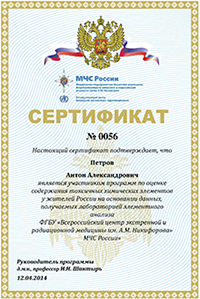It is important to know:
Why do people choose the Clinic of the Ministry of Emergency Situations?
Which steps necessary to do the test?
How to determine the amount of manganese in the human body
Dear friends!
We are honored to present you manganese (Mn), the vital trace element, located under the number 25 in the periodic table.

Manganese was discovered by a Cornish chemist Humphry Davy in 1808. However, the first experiments, conducted by scientists C. W. Scheele and J. G. Gahn in order to derive it, date back to 1774. Initially, the element was called magnesia or magnesium and eventually its name was changed to "manganum". "Manganese" takes its name from Latin word "magnes" which means " a magnet".
Manganese is a heavy, silvery-white metal, a trace element of essential nature, which means that it is not capable of self-generating in the human body, getting into it with food and from the environment, but it must be present in the body in order to ensure its normal functioning. Moreover, manganese is a cofactor of more than 30 enzymes, involved in the vital activity of the body.
Manganese plays a very important role in cellular metabolism, mainly being comprised in mitochondria.
5-10% of manganese which gets into the body with food through the gastroenteric tract, gets absorbed quite quickly. 40% of absorbed manganese almost immediately gets excreted through biliary ducts or the biliary system. Therefore, the concentration of this element in bile is among the markers of its lack in the human body.
Manganese also gets excreted with urine and detached epithelium, being comprised in the skin. Skin burns cause severe losses of manganese.
The biggest part of manganese in the body is contained in the organs with significant amount of mitochondria, i.e. brain, liver, kidneys, pancreas, intestines.
Interacting of manganese and the other elements can be characterized by the following features:
Calcium compounds, phosphates, iron, copper and selenium inhibit intestinal absorption of manganese, therefore taking calcium for osteoporosis aggravates its lack due to its laborious digestion.
Food reach in tannin and oxalate, such as tea and spinach, also inhibit the absorption of manganese.
Lack of iron can lead to intoxication, caused by exceeded level of manganese due to its increased bioavailability. The exceeded level of manganese increases the lack of copper and magnesium. As for aluminum, it significantly reduces the concentration of manganese in the human body.
Histidine helps to excrete manganese from the body.
Manganese is actively involved in the activity of the following systems and organs:
- The hematopoietic system (activates the development of blood cells, or hemopoiesis);
- The immune system (stimulation of phagocytosis and proliferation of T and B cells);
- The nervous system (stimulation of catecholamine metabolism, protection of neurons from apoptosis);
- Metabolism of thyroid hormones;
- Metabolism (support of energy forming, metabolism of proteins, carbohydrates and fat and metabolism of vitamins and minerals);
- The antioxidant protection of cells;
- Saping of bones and connective structures, stimulation of tissue growth and regeneration;
- The reproductive system.
The lack of manganese manifests itself thorough the following clinical symptoms, diseases and pathological conditions:
• the brittleness of bone, impaired cartilage formation, growth inhibition of hair and nails;
• dermatitis, allergies;
• the degenerative changes in ovaries and testes, infertility, the sexual dysfunction;
• the dyspeptic syndrome;
• epilepsy and the convulsive syndrome;
• the alcohol intolerance;
• sugar intolerance, insulin-resistant diabetes;
• increased blood cholesterol levels;
• hepatic steatosis (liver disorder);
• anemia;
• schizophrenia and Parkinson's disease;
• cerebral palsy (CP);
• delayed psychoverbal development;
• growth inhibition, weightloss;
• dysfunctions of reproduction;
• damaged cardiomyocytes excluding prior ischemia, etc.
Lack of manganese is especially dangerous for pregnant women, causing the anomalies in skeletal shaping and dysplasia of connective tissue of a fetus, and for children, leading to an increased tendency to respiratory, food and skin allergies, neurotic reactions and seizures.
The toxic effect of the exceeded level of manganese is mainly aimed at the central nervous system and the bronchopulmonary epithelium. Manganese is capable of penetrating hematoencephalic barrier by more than 60% and accumulating in the brain nucleus. The brain of a newborn is especially vulnerable to penetration of 2-valent manganese.
The exceeded level of manganese manifest itself through the following clinical symptoms:
• neurosis-like states, with elements of somatized depression, anxiety, asthenia, a slightly decreased mental functions, impaired coordination of movements;
• increased fatigue, drowsiness, decrease in activity and range of interests;
• vegetative dystonia of parasympathetic type;
• the disorder of the bioelectrical muscle activity of the extrapyramidal insufficiency type, possible revitalized or decreased tendon reflexes, hyperesthesia in the distal extremities;
• hypomimia (immobility of facial muscles), dystonia (uncontrolled movements of the body), hypertonia;
• rachitis, arthritis;
• hypothyroidism (the lack of thyroid hormones).
Speaking of occupational health problems associated with manganese intoxication, there are two concepts i.e. marganism and manganoconiosis which are singled out.
Manganese intoxication occurs in working environment, through dust, aerosols and vapors, containing manganese oxides or salts.
It is worth noting that manganese does not cause acute poisoning. It gets gradually accumulated in the parenchymal organs, bones, brain and spinal cord, causing irreversible negative effects.
Analyzing the requests made by the consumers regarding manganese, we have detected the following variations:
• how to determine the amount of manganese present in the human body;
• how to determine the amount of manganese in the human body;
• how to determine the amount of manganese in the body;
• how to check the level of manganese in the body;
• how to raise the level of manganese in the body;
• how to increase the level of manganese in the human body;
• how can I learn the level of manganese in the human body;
• how the level of manganese in the body can be determined;
• how to replete manganese in the body;
• how to find out the amount of manganese present in the human body;
• how to determine the limit of manganese for a child and an adult;
Answering the questions of “how to determine the amount of manganese is in the human body?” and “how to determine the limit of manganese for a child and an adult?”, we should focus on the unique method of studying inorganic samples (hair, bones, nails, etc.) elaborated within the national healthcare program in the Clinic of the Ministry of Emergency Situations.
The above method provides the most accurate determination of the level of manganese along with detecting indicators of the other 32 vital and toxic trace elements in the body.
Knowing the bioelemental status of your body will allow you to detect its weak points and take appropriate measures aimed at normalizing the level of manganese and of the other elements and, thus, protect yourself and your children from various pathologies both at present and in future.
It is worth keeping in mind that it is impossible to get the accurate data on the level of trace elements in the human body through studies of organic samples (blood, saliva, urine, etc.) The only effective tool aimed at obtaining the mentioned results is spectral analysis, the unique technique with a wide range of studied parameters.
The method of spectral analysis was elaborated on request of the Ministry of Emergency Situations within a program aimed at monitoring the content of trace elements in the bodies of its employees. Its main task involved identifying heavy toxic trace elements which could not be detected with any other method along with getting the data on the essential elements.
Toxic trace elements get systematically accumulated in the tissues, organs, bones and other body structures, therefore it is impossible to detect their exact presence through studies of the organic samples such as urine, blood, cerebrospinal fluid, saliva, etc.
It also applies to the detection of the vital trace elements when their exact quantity needs to be determined in order to build an overall picture of the bioelemental status qua the aggregate of vital and toxic elements.
That is exactly why the unique laboratory of elemental analysis aimed at detecting and monitoring the presence of toxic trace elements in the human body of was launched within the Clinic of the Ministry of Emergency Situations in 2007. The service was initially meant for employees of the huge structure accountable to the Ministry of Emergency Situations.
The spectral analysis (you can learn more about the method by clicking this link http://www.mineralogram.com/bioelementnyystatus.html) is a unique method which provides the most accurate information both on vital and toxic trace elements, present in a human body, which makes it possible to study the wide range of indicators instead of focusing on a certain single chemical element.
You can look into an example of the study done through the method of the spectral analysis by clicking this link.
It is a matter of great importance, since the trace elements constitute a single system and the lack of some elements causes the accumulation of the others, which results in replacement of the certain elements with the other once.
As you might see, our project is fully devoted to the spectral analysis and its principle with regard to health control. We will gladly assist you at every step of this study, elucidate the obtained results and, if necessary, advise you on how to restore the elemental status of your body.
Our experts will be happy to answer any questions you may have regarding the method of spectral analysis!
The uniqueness of this method makes it possible to study samples sent from any part of the world as a usual letter. It is a truly unique tool of the health control.
Remember that the systematic control over the vital sighs it is the major step on the way to well-being and longevity.
We would like to thank you for your kind attention!
Yours faithfully, 33 Elementa.Ru
Publications
Is eating with a silver spoon bad for health of children and adults? Myth or real danger to the bodyRead >>
At the present review we do akcent on question: – “Why do patients choose the Clinic of the Ministry of Emergency Situations of Russia? ”.Read >>
The concept of the health control as a factor of the awareness of the body-related issues and the proper attitude towards themRead >>





